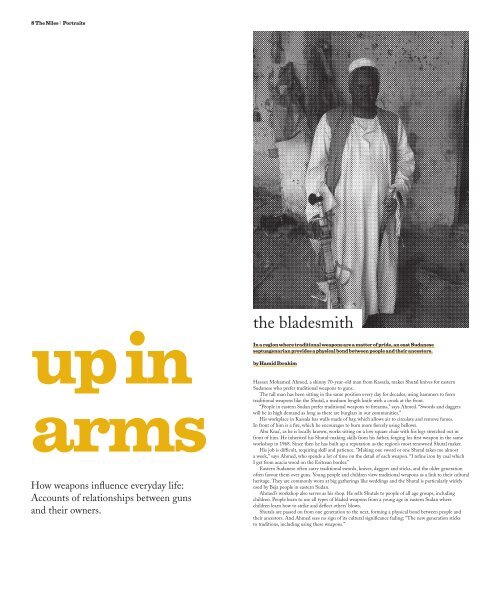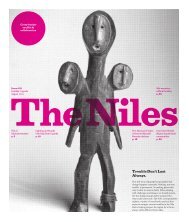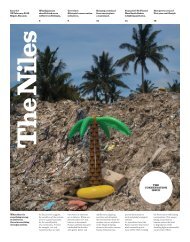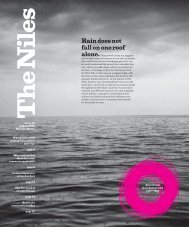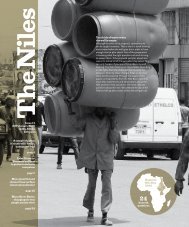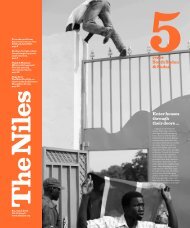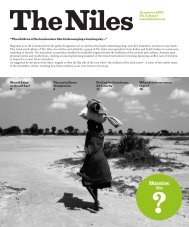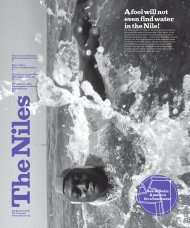If the evil is coming, shut the door...
Approximately three million small arms are circulating in Sudan and South Sudan. In the fourth edition of The Niles, our correspondents from both countries take a closer look: Where do the weapons come from? What societal role do they play? But most importantly: How many weapons are needed to establish peace and to ensure that the door on evil no longer has to be shut, as the above proverb suggests? A Darfuri fighter (photo), has a practical answer – a collection of talismans meant to protect him from bullets. But will it protect him from the person with his finger on the trigger? Albert Einstein, whose Theory of Relativity was proven in a 1952 experiment carried out in Sudan said: “The world will not be threatened by evil people rather by people who permit it.” Those words ring true here and will hopefully open another door and allow something good to slip in.
Approximately three million small arms are circulating in Sudan and South Sudan. In the fourth edition of The Niles, our correspondents from both countries take a closer look: Where do the weapons come from? What societal role do they play? But most importantly: How many weapons are needed to establish peace and to ensure that the door on evil no longer has to be shut, as the above proverb suggests? A Darfuri fighter (photo), has a practical answer – a collection of talismans meant to protect him from bullets. But will it protect him from the person with his finger on the trigger? Albert Einstein, whose Theory of Relativity was proven in a 1952 experiment carried out in Sudan said: “The world will not be threatened by evil people rather by people who permit it.” Those words ring true here and will hopefully open another door and allow something good to slip in.
Create successful ePaper yourself
Turn your PDF publications into a flip-book with our unique Google optimized e-Paper software.
8 The Niles | Portraits<br />
up in<br />
arms<br />
How weapons influence everyday life:<br />
Accounts of relationships between guns<br />
and <strong>the</strong>ir owners.<br />
<strong>the</strong> bladesmith<br />
In a region where traditional weapons are a matter of pride, an east Sudanese<br />
septuagenarian provides a physical bond between people and <strong>the</strong>ir ancestors.<br />
by Hamid Ibrahim<br />
Hassan Mohamed Ahmed, a skinny 70-year-old man from Kassala, makes Shutal knives for eastern<br />
Sudanese who prefer traditional weapons to guns.<br />
The tall man has been sitting in <strong>the</strong> same position every day for decades, using hammers to form<br />
traditional weapons like <strong>the</strong> Shutal, a medium length knife with a crook at <strong>the</strong> front.<br />
“People in eastern Sudan prefer traditional weapons to firearms,” says Ahmed. “Swords and daggers<br />
will be in high demand as long as <strong>the</strong>re are burglars in our communities.”<br />
H<strong>is</strong> workplace in Kassala has walls made of hay, which allows air to circulate and remove fumes.<br />
In front of him <strong>is</strong> a fire, which he encourages to burn more fiercely using bellows.<br />
Abu Kraa’, as he <strong>is</strong> locally known, works sitting on a low square chair with h<strong>is</strong> legs stretched out in<br />
front of him. He inherited h<strong>is</strong> Shutal-making skills from h<strong>is</strong> fa<strong>the</strong>r, forging h<strong>is</strong> first weapon in <strong>the</strong> same<br />
workshop in 1968. Since <strong>the</strong>n he has built up a reputation as <strong>the</strong> region’s most renowned Shutal maker.<br />
H<strong>is</strong> job <strong>is</strong> difficult, requiring skill and patience. “Making one sword or one Shutal takes me almost<br />
a week,” says Ahmed, who spends a lot of time on <strong>the</strong> detail of each weapon. “I refine iron by coal which<br />
I get from acacia wood on <strong>the</strong> Eritrean border.”<br />
Eastern Sudanese often carry traditional swords, knives, daggers and sticks, and <strong>the</strong> older generation<br />
often favour <strong>the</strong>m over guns. Young people and children view traditional weapons as a link to <strong>the</strong>ir cultural<br />
heritage. They are commonly worn at big ga<strong>the</strong>rings like weddings and <strong>the</strong> Shutal <strong>is</strong> particularly widely<br />
used by Beja people in eastern Sudan.<br />
Ahmed’s workshop also serves as h<strong>is</strong> shop. He sells Shutals to people of all age groups, including<br />
children. People learn to use all types of bladed weapons from a young age in eastern Sudan where<br />
children learn how to strike and deflect o<strong>the</strong>rs’ blows.<br />
Shutals are passed on from one generation to <strong>the</strong> next, forming a physical bond between people and<br />
<strong>the</strong>ir ancestors. And Ahmed sees no sign of its cultural significance fading: “The new generation sticks<br />
to traditions, including using <strong>the</strong>se weapons.”


